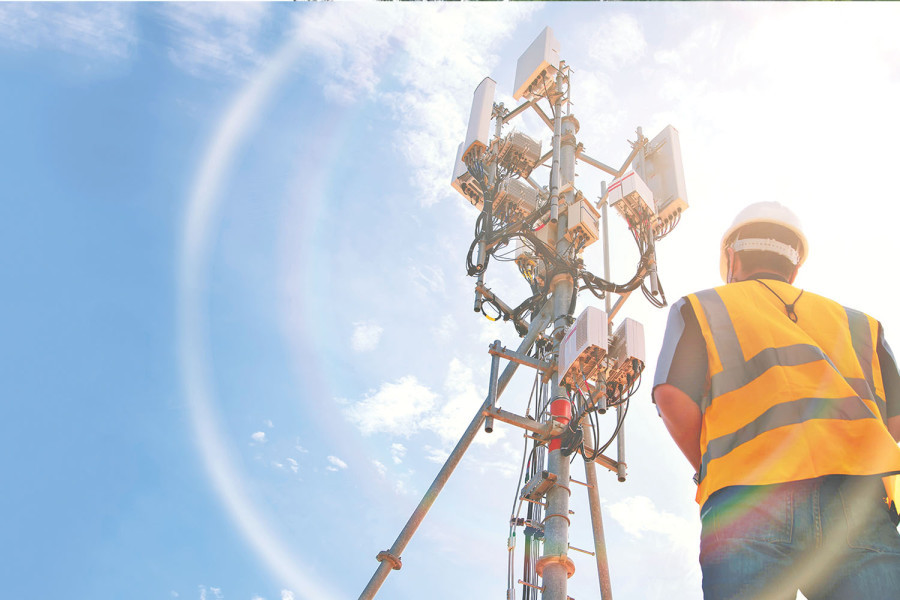Money
Nepal lags behind its regional peers in adopting 5G technology
The country lifted its TikTok ban recently but has shown no urgency in rolling out 5G, with Huawei in tow, insiders say.
Krishana Prasain
Nepal appeared to be a potential early adopter of 5G wireless cellular technology. However, it now lags behind its regional peers when it comes to the introduction of high-speed wireless internet technology.
Six neighbouring countries—India, Bangladesh, Bhutan, Maldives, Sri Lanka, and Afghanistan—have already introduced the service. The Maldives was the first South Asian country to get 5G.
The ‘Digital Nepal Framework 2019’ had taken a lead in 5G adoption in South Asia. But frequent government changes and geopolitical manoeuvrings pushed back the plan’s implementation.
Nepal lifted its ban on the popular Chinese app TikTok but, insiders say, it has shown no urgency in rolling out 5G. The network’s trial has been contracted to Huawei, the Chinese company that helped Nepal launch 4G in 2017.
The state-run telecom company says that the plan to roll out 5G, the high-speed wireless internet technology, may take months or even years as it has not yet had any commercial traffic.
The exodus abroad of young Nepali people, who are avid users of the internet, has also worried service providers.
The current generation of wireless internet is at least 10 times the speed of 4G and is even faster than most people get from their wired broadband connections at home.
“We are not sure about the launch of 5G. It may take months or years to introduce 5G to the public as we are yet to conduct a commercial feasibility study,” said a top official at Nepal Telecom, who wished not to be named.
“As introducing 5G requires huge investment. We must study the commercial aspect, too.”
Officials estimate investment of around Rs50-60 billion to implement the technology.
An initial report after the closed 5G trial shows that the new technology is technically feasible, but since 5G supportive devices are comparatively few, it would make no business sense.
South Asia’s two smallest nations—Bhutan and the Maldives—have commercial 5G services. According to the report, in the Maldives, it is used only by overseas visitors with 5G phones as such devices were not available locally. The service was available in three regions only.
5G is seen as a key enabler of Digital Drukyul, Bhutan’s five-year plan launched in 2018. The plan aims to “harness the power of ICT to transform Bhutan into a smart and inclusive society”.
The state-owned Nepal Telecom had planned to start trials in July 2021, but following the regulatory approval for 5G testing in November 2021, it deferred the trial launch date to June 2022.
The commercial services were planned for August 2022.
Nepal Telecom now says it is conducting a commercial feasibility study of 5G.
The telecom regulator has already said it is ready to allow 5G frequency and is waiting for service providers’ response.
The Nepal Telecommunications Authority, the regulator, has said that service providers should clear all their government debts to take part in the auction.
Talking to the Post on Tuesday, a highly placed source at the ministry said a high-ranking official from the International Telecommunication Union's South Asia region met with communication ministry officials and discussed a range of issues, including the 5G network.
“Many things were discussed. The ITU official suggested looking into priority areas costs to introduce the fast technology and business from both public and commercial use before it is opened for public use,” the source added.
While the state-owned telecom utility has been delaying the 5G launch, the private telecom service provider Ncell said it is “ready for 5G adoption”, though it may take some time as the equipment and network need to be readied accordingly.
The government has not allowed Ncell to trial 5G despite its request.
Recently, Ncell introduced Sadhain On data packages to prepare customers for 5G.
“There are device constraints and few use cases currently, but once allowed, the company will introduce the suitable and appropriate service for its users,” according to Ncell.
Telecom insiders say 4G’s expansion across the country has not been fully utilised. Therefore, a shift to 5G technology will take some time yet.
According the report titled ‘Mobile network experience varies significantly across South Asia’ written by Hardik Khatri and published by Opensignal in November 2023, users in Nepal, Pakistan and Bangladesh spend between 12.4 percent to 14.8 percent of time connected to 3G networks, which drops to 5.8 percent in Sri Lanka. Users in India spend just 0.8 percent of their time connected to 3G.
In Nepal, less than 9 percent of users rely exclusively on mobile data.
Extensive reliance on older technologies such as 2G or 3G, which offer limited capabilities compared to 4G and 5G, is likely to result in an overall poorer user experience, the report said.
Despite mountainous terrain and infrastructural challenges, time spent on wireless frequency (Wi-Fi) in Nepal is 52.9 percent, much greater than in other South Asian countries, the report said.
The budget for the current fiscal year has a target to export goods and services worth Rs3 trillion in the information technology sector in the next ten years. This has the potential to create 500,000 direct and a million indirect jobs in the field.
Through the budget, the government has announced that Nepal will be developed as an information technology hub and that artificial intelligence will be developed, promoted, and regulated accordingly.




 22.12°C Kathmandu
22.12°C Kathmandu














